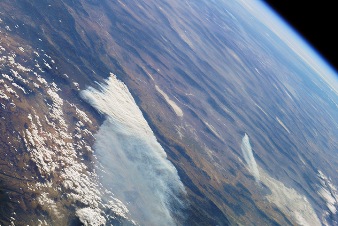Role in aerosol formation could aid modeling of Central Valley temps, air quality

For all we know about climate change and the Earth’s atmosphere, it’s amazing how much more there is to learn. Earlier this month, a team of researchers led by University of Colorado’s Roy “Lee” Mauldin III announced the discovery of a brand new atmospheric compound tied to both climate change and human health.
Above certain parts of the earth, they found, the new compound is at least as prevalent as OH, also called the hydroxyl radical, long thought to be the primary oxidant responsible for turning sulfur dioxide, an industrial pollutant, into sulfuric acid. The new compound, it turns out, can play an equally important role. Sulfuric acid contributes to acid rain and results in the formation of aerosols, airborne particulates associated with a variety of respiratory illnesses in humans and known to seed the formation of clouds.
Mauldin made the discovery by investigating background levels of sulfuric acid in atmospheric samples that were not attributable to OH. He inferred that another compound must be responsible for the effect and was able to isolate it through a series of tests. No one else had ever made the connection before.
[module align=”left” width=”half” type=”pull-quote”]Aerosols are one of the least-understood variables in climate models.[/module]
“As soon as I realized that we were observing a new oxidant, the light clicked on all over the place,” Mauldin said in an interview. “With anything that can produce sulfuric acid, if you can come up with something that occurs on a daily basis, or in this case 24/7, it can affect all sorts of things, including climate and human health.”
In few places is that effect more pronounced than in California. “Aerosols are a major public health problem in the Central Valley,” said Ron Cohen, Director of the Berkeley Atmospheric Sciences Center at the University of California. In fact, they’re worse in the Valley than just about anywhere else in the country — except maybe Los Angeles.
Mauldin believes that the new compound is emitted more heavily by trees than by man-made sources, meaning it may be less important to aerosol formation above the Central Valley than it is above the Finnish Boreal Forest where field research was conducted. But we don’t know that for sure. Nor do we know precisely how to calculate aerosols’ role in climate change.
In fact, aerosols are one of the least-understood variables in climate models, Cohen said. We do know that aerosols contribute to cloud formation, commonly understood to have a cooling effect on the earth. However, we don’t know whether aerosols are changing the height of clouds, which has complex implications for temperature: low clouds tend to have a cooling effect, while high clouds actually trap heat in the atmosphere. Furthermore, some aerosols reflect heat, while others absorb it.
The new compound offers science a new way of charting the formation of aerosols today as well as an important tool for determining what the atmosphere was like before we came along. Both uses are likely to fine-tune our ability to understand and forecast climate change moving forward. As far as what, precisely, it’ll tell us — well, that remains to be seen.
2 thoughts on “New Atmospheric Compound Impacts Climate, Human Health”
Comments are closed.

What is the compound, if not the hydroxyl radical?
It’s a stabilized Criegee intermediate (a carbonyl oxide with two free-radical sites) or its derivative. Yes, “it’s amazing how much more there is to learn” – that’s not even in my chemistry books!